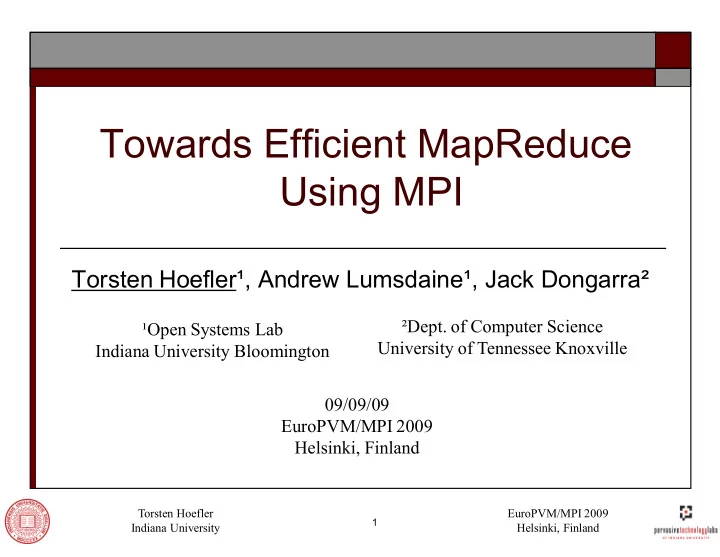

Towards Efficient MapReduce Using MPI Torsten Hoefler¹, Andrew Lumsdaine¹, Jack Dongarra² ²Dept. of Computer Science ¹Open Systems Lab University of Tennessee Knoxville Indiana University Bloomington 09/09/09 EuroPVM/MPI 2009 Helsinki, Finland Torsten Hoefler EuroPVM/MPI 2009 1 Indiana University Helsinki, Finland
Motivation MapReduce as emerging programming framework Original implementation on COTS clusters Other architectures are explored (Cell, GPUs,…) Traditional HPC platforms? Can MapReduce work over MPI? Yes, but … we want it fast! What is MapReduce? Similar to functional programming Map = map ( std::transform() ) Reduce = fold ( std::accumulate() ) 2 Torsten Hoefler, Indiana University EuroPVM/MPI 2009, Helsinki, Finland
MapReduce in Detail The user defines two functions map: input key-value pairs: output key-value pairs: reduce: input key and a list of values output key and a single value The framework accepts list outputs result pairs 3 Torsten Hoefler, Indiana University EuroPVM/MPI 2009, Helsinki, Finland
Parallelization Map and Reduce are pure functions no internal state and no side effects application in arbitrary order! MapReduce done by the framework can schedule map and reduce tasks can restart map and reduce tasks (FT) No synchronization implicit barrier between Map and Reduce 4 Torsten Hoefler, Indiana University EuroPVM/MPI 2009, Helsinki, Finland
MapReduce Applications Works well for several applications sorting, counting, grep, graph transposition Bellman Ford and Page Rank (iterative MR) MapReduce has complex requirements express algorithms as Map and Reduce tasks similar to functional programming ignore: scheduling and synchronization data distribution fault tolerance monitoring 5 Torsten Hoefler, Indiana University EuroPVM/MPI 2009, Helsinki, Finland
Communication Requirements two phases, three communication phases a) Read input for read N input pairs: b) Build input lists for order pairs by keys and transfer to tasks: Output data of c) usually negligible two critical phases: a) and b) 6 Torsten Hoefler, Indiana University EuroPVM/MPI 2009, Helsinki, Finland
All in one view 7 Torsten Hoefler, Indiana University EuroPVM/MPI 2009, Helsinki, Finland
Parallelism limits map is massively parallel (only limited by N) often data usually divided in chunks (e.g., 64 MiB) either read from shared FS (e.g., GFS, S3, …) or available on master process reduce needs input for a specific key tasks can be mapped close to the data worst-case is an irregular all-to-all we assume worst case: input only on master and keys evenly distributed 8 Torsten Hoefler, Indiana University EuroPVM/MPI 2009, Helsinki, Finland
An MPI implementation Straight-forward with point-to-point not focus of this work MPI offers mechanisms to optimize: 1) Collective operations optimized communication schemes 2) Overlapping communication and computation requires good MPI library and network 9 Torsten Hoefler, Indiana University EuroPVM/MPI 2009, Helsinki, Finland
An HPC-centric approach Example: word count Map accepts text and vector of strings Reduce accepts string and count Rank 0 as master, P-1 workers MPI_Scatter() to distribute input data Map like standard MapReduce MPI_Reduce() to perform reduction Reduce as user-defined operation HPC-centric, orthogonal to simple implementation 10 Torsten Hoefler, Indiana University EuroPVM/MPI 2009, Helsinki, Finland
Reduction in the MPI library Built-in or user-defined ops as must be associative (MPI ops are) number of keys must be known by all procs can be reduced locally (cf. combiner ) MPI_Reduce_local keys must have fixed size identity element with respect to if not all processes have values for all keys Obviously limits the possible reductions No variable-size reductions! 11 Torsten Hoefler, Indiana University EuroPVM/MPI 2009, Helsinki, Finland
Optimizations Optimized implementation hardware optimization, e.g., BG/P communication optimization, e.g., MPICH2, OMPI Computation/communication overlap? pipelining with NonBlocking Collectives (NBC) accepted for next generation MPI (2.x or 3.0) offered in LibNBC (portable, OFED optimized) 12 Torsten Hoefler, Indiana University EuroPVM/MPI 2009, Helsinki, Finland
Synchronization in MapReduce 13 Torsten Hoefler, Indiana University EuroPVM/MPI 2009, Helsinki, Finland
Performance Results MapReduce application simulator Map tasks receive specified data and simulate computation Reduce performs reduction over all keys System: Odin at Indiana University 128 4-core nodes with 4 GiB memory InfiniBand interconnect LibNBC (OFED optimized, threaded) 14 Torsten Hoefler, Indiana University EuroPVM/MPI 2009, Helsinki, Finland
Static Workload Fixed workload: 1s per packet Reduction of comm/synch overhead of 27% 15 Torsten Hoefler, Indiana University EuroPVM/MPI 2009, Helsinki, Finland
Dynamic Workload Dynamic workload: 1ms-10s Reduction of execution time of 25% 16 Torsten Hoefler, Indiana University EuroPVM/MPI 2009, Helsinki, Finland
What does MPI need? Fault Tolerance MPI offers basic inter-communicator FT no support for collective communications checking if a collective was successful is hard collectives might never return (dead-/lifelock) Variable Reductions MPI reductions are fixed-size MR needs reductions of growing/shrinking data Also useful for higher languages like C++, C#, or Python 17 Torsten Hoefler, Indiana University EuroPVM/MPI 2009, Helsinki, Finland
Conclusions We proposed an unconventional way to implement MapReduce efficiently uses collective communication limited by MPI interface allows efficient use of nonblocking collectives Implementation can be chosen based on properties of Map and Reduce MPI-optimized implementation if possible point-to-point based implementation otherwise 18 Torsten Hoefler, Indiana University EuroPVM/MPI 2009, Helsinki, Finland
Questions Questions? 19 Torsten Hoefler, Indiana University EuroPVM/MPI 2009, Helsinki, Finland
Recommend
More recommend